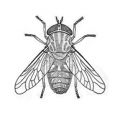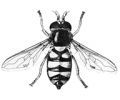Fly
Fly (machhi) the name commonly used for any of a variety of winged insects, but properly restricted to members of the order Diptera, the true flies, which includes among others the housefly, gnat, midge, mosquito, and tsetse fly. Except for a few wingless species, they all bear only one pair of wings. The hind pairs are reduced to knobbed balancing organ called halteres.
In Bangladesh the common indoor fly species include the housefly (Musca domestica), the lesser housefly (Fannia canicularis), the biting housefly or stable fly (Stomoxys), the blue bottles or blow flies (Calliphora), the green bottles (Lucilia), and the flesh flies (Sarcophaga). Some outdoor flies are the black flies, the deer flies and the horse flies, the hover flies, the daddy long legs or crane flies, and many muscoids. The sand flies (Phlebotomus) can be found both indoor and outdoor.
Flies are more familiar for their negative aspects. Houseflies transmit serious diseases like cholera and typhoid. Many are annoying blood-sucking types as the deer flies (Chrysops), and the stable flies (Stomoxys), while swarms of sweat flies and face flies are a nuisance as they gather to suck up sweat and other body secretions. Fruit flies cause damage to crops, fruits and vegetables. But some flies are beneficial as parasitoids of insect pests and some are important as pollinators of various plants.
-
Tabanid fly
-
Stable fly
-
Syrphid fly
-
Robar fly
In Bangladesh, the 'fly' that is most notorious is Musca domestica, the common housefly since it transmits lethal diseases such as diarrhoea and cholera. Little, however, is known about the types and number of species of flies occurring in Bangladesh. A few species have been recorded from filth, and from forests flowers and households.
Flies belonging to Muscidae (housefly) and Calliphoridae (blowfly) transmit diarrhoea, cholera, dysentery, and typhoid in Bangladesh. They breed in garbages and moist, dirty places. Sarcophagids cause myiasis in domesticated animals. Some sand flies belonging to Psychodidae are the vectors of Kala-azar, a fast returning protozoan disease in Bangladesh. They may cause 'oriental sore' on a low scale. Sand flies breed in moist, dark, dirty places around households, common conditions in rural Bangladesh. Tabanid flies cause anthrax, a common cattle disease in Bangladesh. Black flies of Simuliidae can be a nuisance because of their painful bites in the country's hilly areas where they breed in fast-flowing streams. The ceratopogonid biting midges breed in shallow waterbodies in the vast plains of the country and can inflict painful bites at dusk time. Though not reported from Bangladesh, the commonly available syrphid maggots cause intestinal myiasis. At least four species of tephritid fruitfly Dacus cause serious damage to fruits and vegetables all over Bangladesh. [KM Nurul Huda]
Fruitfly common name for a large and diversified groups of cyclorrhaphan Diptera of the family Tephritidae. The term 'fruitfly' is applied because most of them feed and breed in a wide variety of fruits and vegetables all over the world, but are most prevalent in the tropics and sub-tropics. Fruitfly measures from 1 to 20 mm in length and 2 to 30 mm in wing spread. They are often referred to as 'pea-cock flies' because they strut about and vibrate their wings, showing off elaborate multicolour patterns on their wings and the body proper.
The most notorious fruit flies of the world are the Mediterranean Fruitfly or Medfly (Ceratitis capitata), the Oriental Fruitfly' [Dacus (Bactrocera) dorsalis], and the Melon fly' [Dacus (Zeugodacus) cucurbitae].
The family Tephritidae, as a whole, is exclusively phytophagous, feeding upon bacteria and the juice of higher flowering plants. Based on the differential phytophagy of the larvae, fruit flies are grouped into 4 categories, namely, 1. those living in fruits, especially fleshy ones (eg, dacines and a few trypetines); 2. those living in the flower heads of Compositae (most tephritines and some myopities); 3. leaf and stem miners (some tephritines and trypetines); and 4. gall-formers on various parts of plants (oedaspidines and some trypetines).
The most important fruitflies of the first category are the dacines. Although knowledge of the fruitflies of Bangladesh is yet incomplete, the 5 species of Dacus recognized are: Dacus (Zeugodacus) cucurbitae, D. (Z.) tau, D. (Hemigymnodacus) diversus, D. (Bactrocera) dorsalis, and D. (B.) zonatus. All these five species have some common features (although they show some subgeneric variations). The flies forage all day long in host plants and take rest nearby at night. The adult flies feed on fruits, vegetables and flower juice in nature. Eggs are laid inside the host materials by puncturing them with their piercing ovipositor. The larvae feed on the contents of host materials.
The hosts of fruitflies are mainly younger fruits (generally termed vegetables) of cucurbitaceous plants including ash gourd, bitter gourd, kankrol, bottle gourd, cucumber, melon, water melon, ribbed gourd, sponge gourd, snake gourd, and sweet gourd. They occasionally breed in the ripening fruits of mango, star fruit, and guava.
In Bangladesh the species of Dacus (Zeugodacus) are most prevalent in September and least in December, those of Dacus (Hemigymnodacus) are most prevalent in February-March and least in October, and those of Dacus (Bactrocera) are most prevalent in September and least in January. Among various types of vegetables, the intensity of infestation is highest in the sweet gourd. [Md Abdus Sattar Molla]




